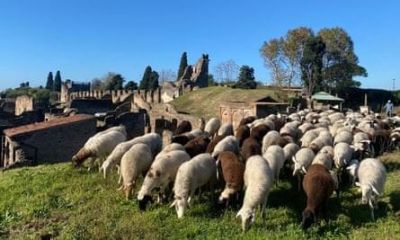In late November, a flock of lawn-mowing sheep were released to trim unruly grass surrounding the ruins of Pompeii as part of an agricultural initiative for the site that also includes plans to revive ancient vineyards. The 150 sheep arrived in Pompeii and immediately got to work munching away in an unexcavated section of Regio V, a vast area to the north of the archaeological park. As part of a nine-month experiment, the flock will also be deployed to trim other grassed areas as well as maintain ancient and new vineyards as park authorities seek to boost the production of Pompeii wine. “They entered the site with great enthusiasm and got to work straight away,” said Gabriel Zuchtriegel, the director of the Pompeii archaeological park. “Maintenance is a huge cost, so instead of paying someone to cut the grass we have sheep eating it, fertilizing it and creating a pastoral landscape that is much more resistant to dry seasons and heavy rainfall.” The lawn-mowing method has caught on in other places around the world as an ecological way to reduce energy use and costs. “Many people think of Pompeii as an ancient city with lots of houses, but it’s actually much more than this,” said Zuchtriegel. “There are huge areas of trees, grass, olive groves and vineyards. And if you look back at photos from 100 years ago in southern Italy, or even in the 1950s, it’s astonishing to see the walls around Pompeii, Paestum and other sites – they didn’t have these problems with growing vegetation because every square meter was productively used by these peasant communities.”
A novembre un gregge di pecore fu portato a Pompei per pascolare nei campi. L'obiettivo era che le pecore mangiassero l'erba alta intorno alle rovine. Parte di un'iniziativa agricola, gli archeologi vogliono far rivivere l'area e gli antichi vigneti. Le 150 pecore giunsero a Pompei e iniziarono subito a pascolare l'area non scavata, denominata Regio V, che si trova a nord delle rovine. L'esperimento di avere pecore fa parte di un piano che durerà 9 mesi. Il gregge sarà portato in altre zone di Pompei nella speranza che i campi aiutino le viti a crescere. Gabriel Zuchtriegel, il direttore dei parchi archeologici di Pompei, ha detto che le pecore stanno facendo esattamente quello che volevano che facessero. Ha spiegato che la gestione del campo è molto costosa e con l'aiuto delle pecore stanno risparmiando denaro. Le pecore aiutano anche i campi con la fertilizzazione necessaria per avere un terreno resistente alla siccità o alle forti piogge. Il metodo di utilizzo delle pecore è un sistema utilizzato in tutto il mondo. È un modo ecologico per ridurre i costi di manutenzione della terra e anche ridurre l'energia. Zuchtriegel ha anche spiegato che molte persone pensano che Pompei sia solo una città antica. Al contrario, è un luogo dove ci sono zone ricche di alberi, prati, uliveti, vigneti. Nelle foto di più di 100 anni fa o degli anni '50 si vedono le zone fuori le mura di Pompei e Paestum senza problemi di vegetazione perché le comunità usavano le piante per vivere. Al giorno d'oggi, le comunità non hanno bisogno del verde in questa zona, quindi le pecore aiutano.



